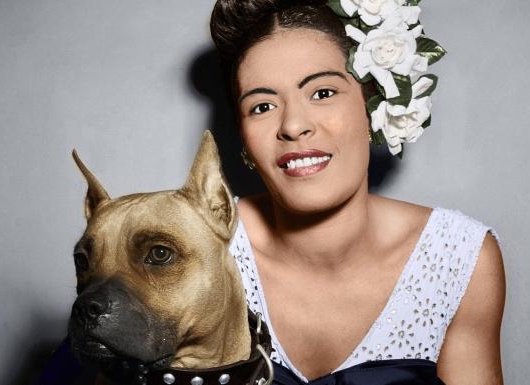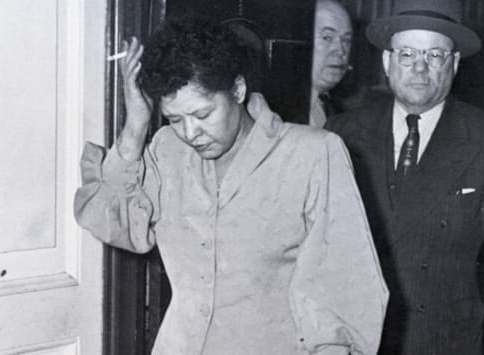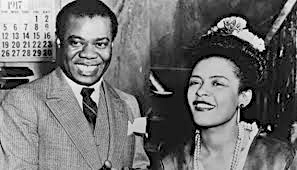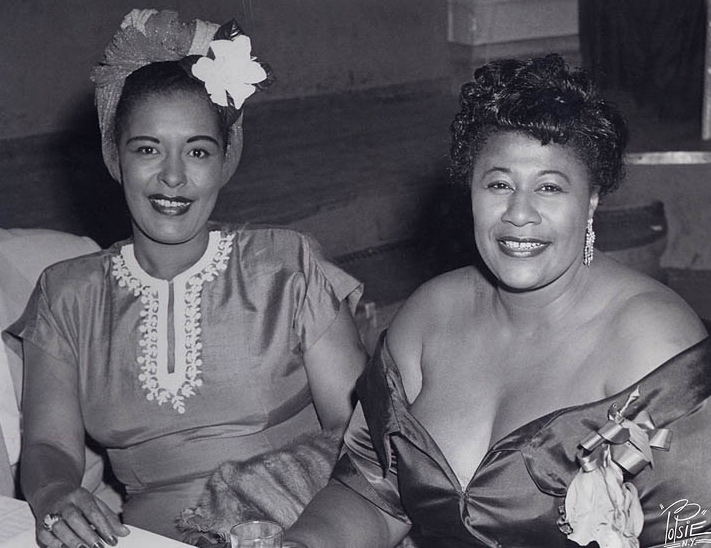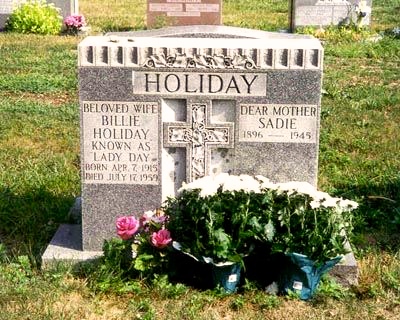“I don’t think I’m singing. I feel like I am playing a horn. I try to improvise like Les Young, like Louis Armstrong or someone else I admire. What comes out is what I feel. I hate straight singing. I have to change a tune to my own way of doing it. That’s all I know.” Billie Holiday, Nov. 1, 1939
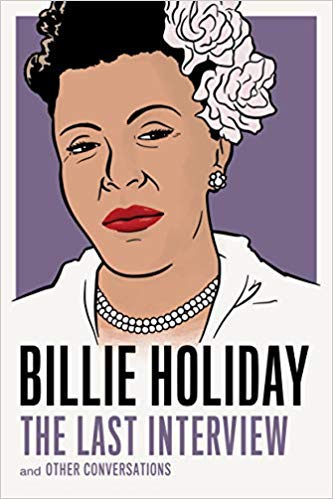 In Melville House Publishing’s Last Interview series, Billie Holiday’s own words define her and reflect her difficult life through eight interviews. The first is given on November 1, 1939, published in Downbeat Magazine, and the last is twenty years later, published in October, 1959, in Confidential Magazine, an interview she granted two days before her death in a New York hospital at age forty-four. Born in Philadelphia on April 7, 1915, her life was hard lived, and when she died, a victim of her addictions to drugs and alcohol, she was depressed about her life and the fact that she might be forgotten. Her fans, she believes, “forget the laughter and the weeping I brought to people who waited for a voice to sing the happy and the crying songs they wanted so much to hear. They don’t remember the woman – they just remember the wreck. That’s how people are – they remember someone else’s misery to forget their own.”
In Melville House Publishing’s Last Interview series, Billie Holiday’s own words define her and reflect her difficult life through eight interviews. The first is given on November 1, 1939, published in Downbeat Magazine, and the last is twenty years later, published in October, 1959, in Confidential Magazine, an interview she granted two days before her death in a New York hospital at age forty-four. Born in Philadelphia on April 7, 1915, her life was hard lived, and when she died, a victim of her addictions to drugs and alcohol, she was depressed about her life and the fact that she might be forgotten. Her fans, she believes, “forget the laughter and the weeping I brought to people who waited for a voice to sing the happy and the crying songs they wanted so much to hear. They don’t remember the woman – they just remember the wreck. That’s how people are – they remember someone else’s misery to forget their own.”
Born in Philadelphia, she grew up in Baltimore, the daughter of Clarence Holiday of the Fletcher Henderson Orchestra, with whom she had little contact after the age of ten. According to Khanya Mtshali, who wrote the substantial Introduction to this book, Billie was raped at around age ten and sent to a Catholic reformatory school for about two years, but was released “with the help of relatives” and later moved to New York with her mother, “where they began engaging in sex work to make ends met. Holiday was only fourteen.” In the the book’s first interview by Dave Dexter, with Downbeat Magazine on Nov. 1, 1939, she talks about those early years when she and her mother “were so hungry we could barely breathe.” Desperate, she began walking down Seventh Avenue one day, stopping at every “joint” looking for work. Eventually, she got her chance, and when the pianist, Dick Wilson, played “Body and Soul,” she soared: “Jeez, you should have seen those people – all of them started crying….[and] that’s how I got my start.” By fifteen, she had recorded a side with Benny Goodman, with Gene Krupa in the band.
Eight years later, in another Downbeat Magazine Interview by Michael Levin on June 4, 1947, Billie has just been released on $1000 bail after her first big arrest for drugs. By that time, according to Wikipedia, she was at her commercial peak, having earned $250,000 in the previous three years. In the Michael Levin Interview, she blames no one but herself for her problems: “Whatever I did wrong, nobody else but me was to blame…I’m not offering an alibi, I’m not singing the blues,” but she then goes on to offer the fact that “my mother died 18 months ago, the only relative I had in the world. I guess I flipped, ran through more than $100,000 since then. But I was trying to go straight. It just seems as though I have a jinx over me.” Though she has already “taken the cure” for three weeks, at a cost of $3000, “Now the federal people tell me they may send me away for another cure…Just when things were going to be so big and I was trying so hard to straighten myself out. Funny, isn’t it?”
Between the first interview in November, 1939, and the second interview, in June, 1947, Billie Holiday recorded her most famous songs: “Strange Fruit,” about lynchings in the South, in 1939; “God Bless the Child,” in 1941, a song which eventually sold over a million copies; “Don’t Explain,” in 1944; “What is This Thing Called Love,” in 1944; and “Good Morning, Heartache,” in 1946. She worked in a major film in September, 1946, with Louis Armstrong and Woody Herman. Unfortunately, her drug problems, according to Wikipedia, were a problem on the set of the film and though she earned over a thousand dollars a week from her club work, “she spent most of it on heroin.” In the 1947 Michael Levin Interview in Downbeat, however, she insists, “I just want to be straight with people, not have their sympathy. And remember, nobody else in show business has made as many mistakes as me.”
By 1952, in her August 16 Interview with Dick Macdougall, she is reminiscing about the “good old days,” including her inspiration from Bessie Smith, who was one of her mother’s friends, and her friendships with with Louis Armstrong, Billy Eckstine, Benny Goodman, Mildred Bailey, Teddy Wilson, Count Basie, and Ella Fitzgerald – her neighbor in New York. By now she has traveled all over the world, but she is not happy about the state of music in 1952. “All the artists are doing are bringing back all the old tunes….There’s really nothing happening….The things that I sing have to have something to do with me and my life, and my friends’ lives, and…it has to have a meaning, you know? The things they’re writing today, nothing’s happening.”
The “Lost Billie Holiday Interview” with George Walsh of KNX Radio Los Angeles, from September 1956, was “unheard for nearly sixty years, until…it was resurrected by Gordon Skene…in 2015” and republished here. Holiday’s manner of speaking in this interview suggested she was “under the influence” and management decided not to air it. Her January, 1959, Statement in the Office of the Supervising Custom Agent, United States Treasury Department, is included here. She had failed to declare to Customs upon entering the country from a stay in Paris and Italy that she had been convicted of narcotics offenses and had served a year and a day at the Federal Reformatory for Women in Alderson, West Virginia. She was unfamiliar with this new regulation and had not seen the notice posted at the airport. Her Final Interview takes place two days before she died on July 17, 1959, and is (surprisingly) attributed to Billie Holiday herself. Dying alone, with a policewoman in her room because a nurse claimed she had bits of heroin on her face, Holiday admits to having been a heroin addict for fifteen years. Ultimately, she says,“I hold no regrets and I carry no shame…If my life was wrong or right – good or bad – it’s still my life and what’s about to happen – will happen just to me….[And] when I leave this lump they call the world, I’m going to leave all my blues behind and walk off singing.” Billie Holiday has truly lived her song, “Don’t Explain.”
Billie Holiday sings “Strange Fruit,” 1959, the year of her death:
Photos: Young Billie Holiday with her dog, Mister. Photo by Rex Shutterstock. https://www.thetimes.co.uk
Billie leaving the police station after her arrest in 1956. https://www.biography.com
Billie with Louis Armstrong, with whom she worked on a film. https://www.biography.com/
Billie with Ella Fitzgerald, her neighbor. https://www.wtju.net
Grave of Billie Holiday with her mother in the Bronx, New York. https://www.pinterest.com
